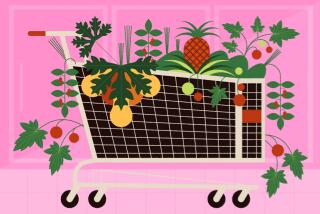Preserve Harvest With Own Solar Food Dryer
- Share via
QUESTION: When fruits and vegetables are on sale, I want to buy large quantities and preserve them by natural drying with no chemical preservatives or cooking. How can I make a simple inexpensive solar food dryer myself?
ANSWER: You should be able to easily build a simple solar food dryer over a weekend for less than $50. Not only will you save money on your groceries, but you won’t heat up your kitchen with cooking and canning.
Drying food is a perfect fit with solar and it is the most natural and nutritious method to preserve foods. Dried food takes up little space and lasts a very long time. Using heat from the sun is free and it does not create pollution or contamination of the environment or your food.
The savings from buying larger quantities of fruits and vegetables on sale should easily pay back the material costs in one summer alone. If you have a garden, you can insure the dried foods are 100% “clean.”
The key to an effective solar food dryer is maintaining a temperature of about 110 degrees in the dryer. There must also be adequate air circulation through it and around the food to carry away the moisture-laden air.
One effective design of a solar food dryer is basically a large open-top plywood box. For the top, use an old storm window with a sheet metal collector beneath it. This black collector absorbs the sun’s heat, yet blocks the direct rays from striking the food. Direct sun may cause food to lose its color and much of its nutritional content.
Build the plywood box with screen-covered vent openings in the top and the bottom ends. The hot moist air naturally exhausts out the top vent, thus drawing cool dry air in the bottom vent. It is important to properly size the vent holes, or there may be too much or too little air flow to keep the dryer at the proper drying temperature.
Attach legs to the box to tilt it up from horizontal at an angle equal to your area’s latitude minus five degrees. This faces it most directly toward the spring, summer and fall sun. Attach shelf supports on the interior sides so they are level when the box is tilted up.
Make screen covered drying shelves slightly shorter than the depth of the box. Stagger every other shelf flush against the back. This makes the warm air wind back and forth across all the shelves to get to the top outlet.
Once you become familiar with your solar food dryer, you will learn to adjust the interior temperature by tilting it slightly higher or lower and adjusting optional small movable side vent covers.
You can write to me for Utility Bills Update No. 527 showing do-it-yourself instructions and diagrams and a material list for making a solar food dryer. Please include $1.50 and a self-addressed business-size envelope. Send your requests to James Dulley, c/o Los Angeles Times, 6906 Royalgreen Drive, Cincinnati, Ohio 45244.
More to Read
Eat your way across L.A.
Get our weekly Tasting Notes newsletter for reviews, news and more.
You may occasionally receive promotional content from the Los Angeles Times.










